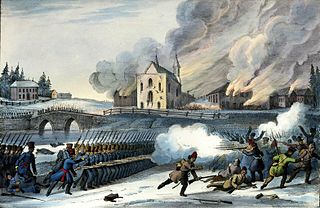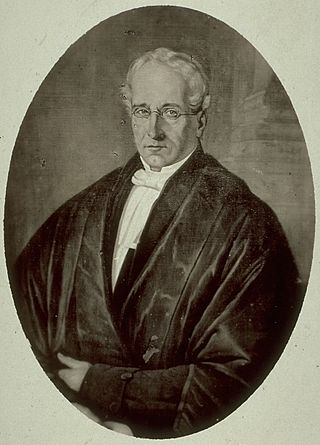Related Research Articles

The Lower Canada Rebellion, commonly referred to as the Patriots' War in French, is the name given to the armed conflict in 1837–38 between rebels and the colonial government of Lower Canada. Together with the simultaneous rebellion in the neighbouring colony of Upper Canada, it formed the Rebellions of 1837–38.

Archibald Acheson, 2nd Earl of Gosford,, styled The Honourable Archibald Acheson from 1790 to 1806 and Lord Acheson from 1806 to 1807, was a British politician who served as Lieutenant-Governor of Lower Canada and Governor General of British North America in the 19th century.

John Arthur Roebuck, British politician, was born at Madras, in India. He was raised in Canada, and moved to England in 1824, and became intimate with the leading radical and utilitarian reformers. He was Member of Parliament (MP) for Bath from 1832 to 1847, and MP for the Sheffield constituency from 1849. He took up the general attitude of hostility to the government of the day, whatever it was, which he retained throughout his life. He twice came to public prominence: in 1838, when, although at the time without a seat in parliament, he appeared at the bar of the Commons to protest, in the name of the Canadian Assembly, against the suspension of the Canadian constitution; and in 1855, when, having overthrown Lord Aberdeen's ministry by carrying a resolution for the appointment of a committee of inquiry into the mismanagement in the Crimean War, he presided over its proceedings.

The Upper Canada Rebellion was an insurrection against the oligarchic government of the British colony of Upper Canada in December 1837. While public grievances had existed for years, it was the rebellion in Lower Canada, which started the previous month, that emboldened rebels in Upper Canada to revolt.
The Ninety-Two Resolutions were drafted by Louis-Joseph Papineau and other members of the Parti patriote of Lower Canada in 1834. The resolutions were a long series of demands for political reforms in the British-governed colony.
The Doric Club was an association of Loyals set up in Lower Canada by Adam Thom, a lawyer and journalist, in March 1836. A noted opponent of the Patriotes, the group was both a social club and a paramilitary organization. It was used as the armed faction of the Constitutional Party and many of its members took part in the Lower Canada Rebellions of 1837 and 1838 on the British side.

This section of the Timeline of Quebec history concerns the events in British North America relating to what is the present day province of Quebec, Canada between the time of the Constitutional Act of 1791 and the Act of Union 1840.

The British North America Act, 1840, also known as the Act of Union 1840, was approved by Parliament in July 1840 and proclaimed February 10, 1841, in Montreal. It abolished the legislatures of Lower Canada and Upper Canada and established a new political entity, the Province of Canada to replace them.

Events from the year 1836 in Canada.

Field Marshal John Colborne, 1st Baron Seaton, was a British Army officer and colonial governor. After taking part as a junior officer in the Anglo-Russian invasion of Holland, Sir Ralph Abercromby's expedition to Egypt and then the War of the Third Coalition, he served as military secretary to Sir John Moore at the Battle of Corunna. He then commanded the 2nd Battalion of the 66th Regiment of Foot and, later, the 52nd Regiment of Foot at many of the battles of the Peninsular War. At the Battle of Waterloo, Colborne on his own initiative brought the 52nd Regiment of Foot forward, took up a flanking position in relation to the French Imperial Guard and then, after firing repeated volleys into their flank, charged at the Guard so driving them back in disorder.

The Rebellion Losses Bill was a controversial law enacted by the legislature of the Province of Canada in 1849. Its passage and subsequent royal assent by the Governor General, James Bruce, 8th Earl of Elgin makes the bill a landmark piece of legislation in Canadian political history.
The constitutional history of Canada begins with the 1763 Treaty of Paris, in which France ceded most of New France to Great Britain. Canada was the colony along the St Lawrence River, part of present-day Ontario and Quebec. Its government underwent many structural changes over the following century. In 1867 Canada became the name of the new federal Dominion extending ultimately from the Atlantic to the Pacific and the Arctic coasts. Canada obtained legislative autonomy from the United Kingdom in 1931, and had its constitution patriated in 1982. Canada's constitution includes the amalgam of constitutional law spanning this history.

Augustin-Norbert Morin was a Canadien journalist, lawyer, politician, and rebel in Lower Canada. Although he participated in the Lower Canada Rebellion, the British authorities concluded his conduct did not warrant a charge of high treason. After the Rebellion, he entered politics in the Province of Canada, eventually becoming joint premier of the Province. Retiring from politics due to health concerns, Morin was appointed to the bench. He was one of the commissioners who codified the law of Lower Canada, producing the Civil Code of Lower Canada which stayed in force for over a century.

Austin Cuvillier was a businessman and political figure in Lower Canada and Canada East. He was a successful Canadien businessmen, unusual when most businessmen in Lower Canada were British. He also was a member of the Legislative Assembly of Lower Canada for twenty years, as a member for the Parti canadien, which tended to oppose the policies of the British-appointed governors. As a result, he served as a bridge between the conservative business community, and the more radical Parti canadien, although he finally broke with the Parti canadien prior to the Lower Canada Rebellion of 1837–1838.

George Moffatt was a businessman and political figure in Lower Canada and Canada East. Born in England, he emigrated to Lower Canada at the age of 14. He became involved in business in Montreal, including the fur trade.
The Select Committee of the House of Commons on the Civil Government of Canada was established by the British House of Commons on May 2, 1828 "to enquire into the state of the civil government of Canada, as established by the Act 31 Geo. III., chap. 31, and to report their observations and opinions thereupon to the house."
The following is an incomplete bibliography of the 1837-1838 insurrections in Lower Canada in the English and French languages, by publication date and document type.
The electoral districts of Lower Canada were territorial subdivisions of the British North American Province of Lower Canada serving as the basis of the representation of the population in the Legislative Assembly of Lower Canada, the lower house of the Provincial Parliament of Lower Canada. This house was the first legislative assembly in the history of Quebec. The districts were used between 1792 and 1838, date at which the constitution of the country was suspended as a consequence of the Rebellions of 1837.
Adam Thom was a teacher, journalist, lawyer, public servant, and recorder.
References
- Reports of Commissioners on Grievances Complained of in Lower Canada. Ordered by the House of Commons to be printed, 20 February 1837, in Parliamentary Papers, 1837, XXIV, 3-416. (online)
- Russell, John. Resolutions intended to be proposed by Lord John Russell, in a committee of the whole house, relative to the affairs of Canada, March 1837 (online)
- Mill, John Stuart. "Radical Party and Canada: Lord Durham and the Canadians", in London and Westminster Review, VI & XXVIII, 502-33, January 1838 (online)